Not Your Grandpa’s Ham Radio 2016
Update
Not Your Grandpa’s Ham Radio Wins ‘Best in Class’ Ribbon
Maker Faire Bay Area was extra-special for us this year: We won a ribbon for “Best in Class.”
Maker Faire Hq. explains there are two ribbon categories: a blue ribbon for best in show, and a red ribbon for best in class. The red ribbons are also used to show the Maker has an educational element.
This red ribbon is an excellent victory, because the Maker Faire staff recognizes for our mission statement:
To show people what today’s ham radio operators are doing with the newest technology, and to change the image of ham radio, making it both contemporary and chic in a hi-tech way. We also want to emphasize how ham radio can be used for science and technology education and a possible career path for youngsters.
Our projects demonstrate how ham radio technology changes with the times, yet still includes both past and present to accomplish one thing: Creating ways to communicate voice and data over the ether, without wires.
Maker Faire Hq. keeps track of Makers as they (we) win ribbons.
Notice several Makers have multiple ribbons. Now we have an additional Maker Faire goal: We need to win a ribbon each year.
Maker Faire Bay Area Team 2016
Left to right: Dennis Kidder W6DQ, Lisa Gibbons KF6QNG, Wayne Yoshida KH6WZ, Marty Woll N6VI, Patricia Yee, Brian Yee W6BY. Not pictured: Joel Wilhite KD6W, Victor Frank K6FV and Paul Zander AA6PZ. The new polo shirts made by Dennis gave booth staff a professional look. Photo by Dennis Kidder.
A Setup Day Tradition and Treat – Gerard’s Paella
Hungry Makers ready for paella and various beverages after setting up their displays and activities.
Volunteers scoop and serve paella to the Makers after Maker Faire Bay Area setup day.
Gerard and his nephew Tom as the paella feast winds down.
This is a tradition at the Maker Faire Bay Area: Gerard’s Paella. Gerard Nebesky trucks in his crew and giant paella pans, which are about 20 feet in diameter. Gerard feeds over 2500 hungry Makers on Friday evening. A great big Thank You goes out to Gerard and his Maker Faire crew!
Here’s a quick video of the paella feast at the 2014 Bay Area Maker Faire.
New Projects
Lightning Detector, Low Frequency (300 kHz) Receiver
The completed lightning detector-300 kHz receiver completed a few nights before the Maker Faire. On the right is the “lightning simulator” – a piezo BBQ striker in a plastic pill bottle.
The lightning detector-300 kHz receiver is built into a broken LCD TV cabinet. Originally, I thought I could re-use the power supply, infrared remote control and audio amplifier. Unfortunately, the TV is built with a small number of ICs with multiple functions. The power supply performed strangely when I probed around to map out the output voltages. Since I was on a tight schedule, I gutted the unit, and kept only the speakers.
Lightning flashes and Tesla coils generate a wide range of radio frequencies near 300 kHz, slightly below the AM broadcast band (540 kHz to 1700 kHz). The electrical impulses can be perceived as “noise” or “static” in a radio receiver.
The Lightning Detector is a “resonant tank circuit” which detects the electrical impulses, amplifies them so the noise can be heard on a speaker, seen on the yellow LED and moves the needle on the meter.
A lightning simulator is used to test or demonstrate the unit in action when no storms are in the area. It is a low frequency, low level oscillator. Another way to simulate lightning is to use a piezo electric striker, like the ones used in some cigarette lighters and gas barbecue starters.
Information on this circuit comes from Charles Wenzel’s Technical Library (TechLib). There are a lot of interesting projects and includes a gallery of readers’ projects.
A Software Defined Radio – Made with Vacuum Tubes
A what made with what?
This is an interesting mix of old and new. Dennis Kidder, W6DQ, came up with this idea. Vacuum tubes are fully capable of performing many of the same functions as modern solid-state devices.
Dennis says, “The best part of using tubes in a project — they look really cool!”
24 GHz Beacon
Brian Yee, W6BY, brought his Amateur radio beacon. A beacon is a one-way radio transmitters usually used as “propagation indicator” to help see how signals are traveling through the air. They can also be used as a signal source or reference to measure frequency, calibrate radio receivers and test antennas. Brian’s beacon operates on the 24 GHz band, and is made with modified microwave telecommunications sub-assemblies. An Arduino Nano is used as the beacon identifier. It sends out Brian’s ham radio callsign W6BY every 10 minutes (an FCC requirement) as well as a series of tones to help locate and identify the beacon.
N6VI Antenna and Spectrum Analyzer Demonstration
Marty Woll brought a portable spectrum analyzer and an assortment of hand-built antennas, including this corkscrew (circular polarized) antenna. A weak signal source was placed at the far end of the booth. By moving the antenna around, the spectrum analyzer shows frequency and signal strength. This can visually demonstrate antenna polarization and direction as well as frequency and harmonics.
KH6WZ 10 GHz Transmitter-Receiver System
The “anchor project” from past events is my 10 GHz transverter system. This station is used to demonstrate and explain frequency multiplication and division, frequency up-conversion (transmitting), down-conversion (receiving), polarization and antenna directivity to non-hams and even children.
W6DQ Software Defined Radio (SDR) Demonstration
Dennis Kidder W6DQ, displayed his software defined radio (SDR). There were many questions about SDRs and many visitors were surprised to learn ham radio operators have this technology. But this is another example of what radio hams are using these days.
Virtual Air Traffic Control Receiving Station Using ADS-B – Automatic Dependent Surveillance – Broadcast
ADS-B is the “next generation” air traffic control, to replace/supplement ground-based radar. Each aircraft transmits identification, GPS position, flight information and other data.
It is very easy to make an ADS-B receiving station. Here are the things needed:
- A digital TV (DVB-T) dongle – DVB-T is Digital Video Broadcast – Terrestrial, a digital TV standard used in Europe and other, non-North American locations
- Antenna for 1090 MHz, this can be built with cable TV coaxial cable and a few other items.
- Windows PC
- ADSB# (ADSB Sharp), a free application
- Virtual Radar Server, another free application
- Browser and Internet Connection
An inexpensive (less than $20 US) digital TV software defined radio in a USB dongle is used to decode ADS-B signals. Free downloadable applications for Windows PCs are used to decode and display the live air traffic broadcasts on a computer.
There is one important thing to know when buying your DVB-T dongle: The decoder and display programs work only with dongles using the Realtek RTL2832U with the RaefaelMicro R820T Tuner chip set.
More ADS-B Receiver Information
“Virtual Radar from a Digital TV Dongle,” QST, January 2014
Virtual Radar Server – Download
Broadband-Hamnet™ (formerly called HSMM-Mesh™) Demo
Dennis W6DQ (seated) assembling the BBHN network demo as Marty N6VI asks a few questions about the network.
Broadband Hamnet (BBHN) re-purposes commercial Wi-Fi equipment to operate only in the ham bands to create robust, wireless, IP-based networks suitable for emergency communications or remote monitoring and control.
Commercial Wi-Fi equipment is restricted through FCC Part 15 regulations, limiting power and range and precluding the user from modifying type-accepted products.
However, licensed ham radio operators are legally allowed to modify Part 15 devices to make them operate in the FCC Part 97 rules for ham radio operation. Larger antennas, higher power, adding receiver pre-amplifiers and other techniques are allowed for experimentation.
The result is a system which creates an ad-hoc, meshed network, supporting IP traffic, e.g., voice, video and data. A meshed wireless network affords greater reliability by providing alternative route paths in the event of a failure.
Dennis says there sure a lot of wires needed for wireless networking.
Note: There are two systems for amateur radio wireless networking – Broadband HamNet (BBHN) and Amateur Radio Emergency Data Network (AREDN). If you are interested in experimenting with this, check with others in your area to see what they are using.
10 GHz / 24 GHz Dual Transmitter-Receiver System
Joel Wilhite KD6W constructed a 10 GHz and 24 GHz dual-band transverter system for portable use. It consists of various modified modules from several sources.
We encourage kids and parents to talk to each other using our home-built radios. It helps make things more interesting than just looking at things.
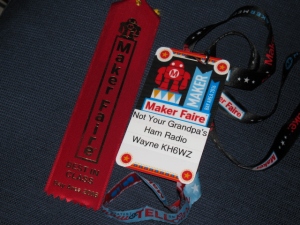
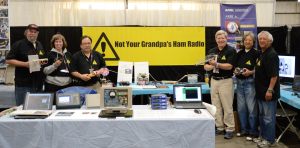
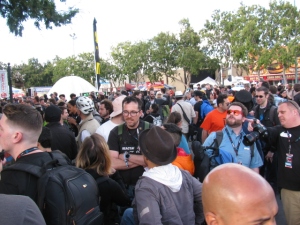
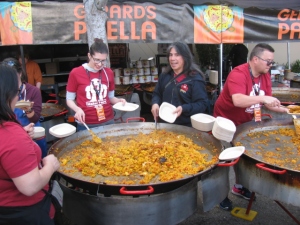
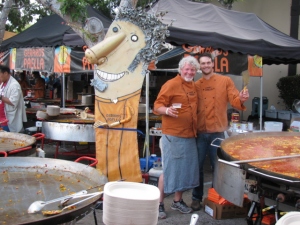
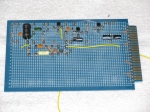
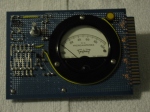
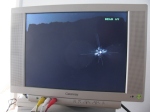
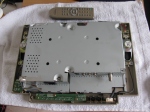
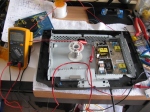

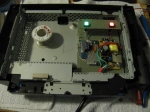
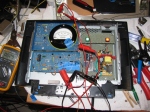
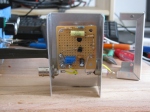
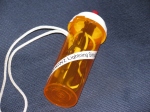
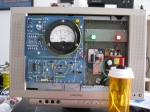
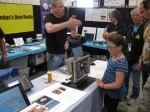
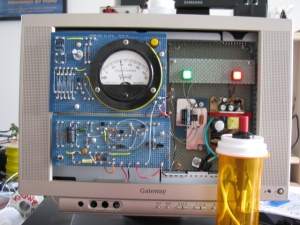

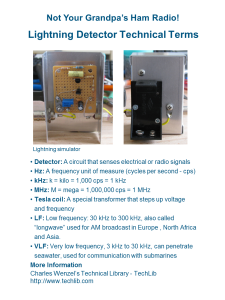
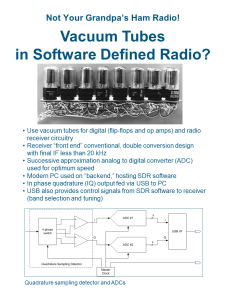
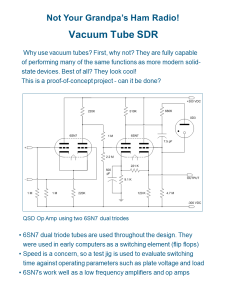
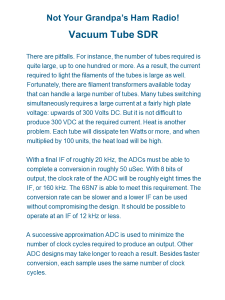

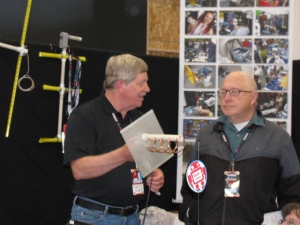
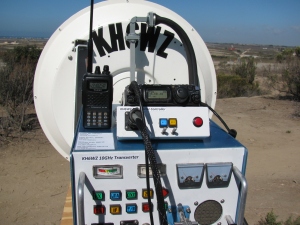
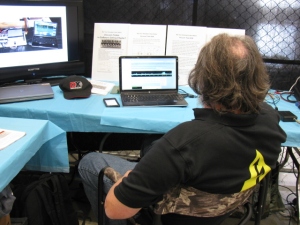
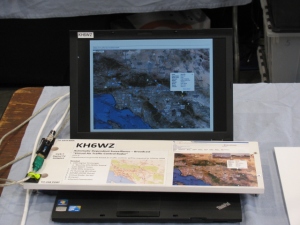
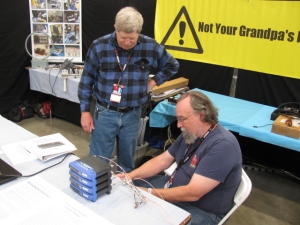
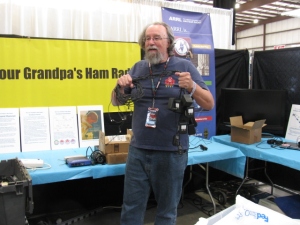
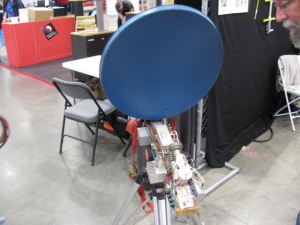
Pingback: Detect Lightning with a Simple Circuit | Make: